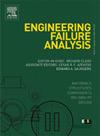Failure analysis and numerical modeling of a fractured chain element from a drawing machine in a metallurgical production plant
IF 4.4
2区 工程技术
Q1 ENGINEERING, MECHANICAL
引用次数: 0
Abstract
Track-type chains are some of the most important production and transportation systems, commonly used in the industry. In the current research, the failure of a fractured chain element was investigated. The fractured material was evaluated via chemical analysis, optical metallography and hardness testing. In order to determine the failure mechanism, the fracture surface was evaluated using macro- and microfractography. The failure mode exhibited typical characteristics, of a microscopically brittle fracture, principally consistent to the occurrence of fatigue cracking followed by overload fracture. Fracture initiated from stress concentration areas and propagated all over the adjacent areas. Moreover, the microscopic fracture morphologies signify an almost uniform microcracking progressed under low-cycle fatigue conditions. The coarse carbide microstructure is suggestive for low fracture resistance, while it promotes a (quasi-)brittle transgranular fracture mode reducing the overall component fracture toughness. Finally, a fatigue simulation of the same chain element was conducted via finite element analysis, under a zero-based, constant amplitude load strain life analysis. For the loading conditions, the loads commonly affecting the chain element during service were applied. The simulation was based on Morrow’s law with 109 cycles infinite lifetime threshold. From the results of the simulation, the stress and damage accumulation points on the chain element were identified and compared to the corresponding experimental findings. The available lifetime of the component was also estimated from the simulation. In the present paper an original industrial case study is presented. To the best of the authors’ knowledge, there was no similar study found in the relevant literature. The significance of the study is considered as quite high, since it is connected to the interruption of the production machine which costs a lot in terms of repair/replacement expenses and most important in production delays and, finally, in compromise of customer service quality and satisfaction. So, the strategy and technical content of the present investigation could stand as a valuable guide and paradigm for similar industrial failure cases, aiming to adopt and pursue a quality and excellence manufacturing model.
求助全文
约1分钟内获得全文
求助全文
来源期刊

Engineering Failure Analysis
工程技术-材料科学:表征与测试
CiteScore
7.70
自引率
20.00%
发文量
956
审稿时长
47 days
期刊介绍:
Engineering Failure Analysis publishes research papers describing the analysis of engineering failures and related studies.
Papers relating to the structure, properties and behaviour of engineering materials are encouraged, particularly those which also involve the detailed application of materials parameters to problems in engineering structures, components and design. In addition to the area of materials engineering, the interacting fields of mechanical, manufacturing, aeronautical, civil, chemical, corrosion and design engineering are considered relevant. Activity should be directed at analysing engineering failures and carrying out research to help reduce the incidences of failures and to extend the operating horizons of engineering materials.
Emphasis is placed on the mechanical properties of materials and their behaviour when influenced by structure, process and environment. Metallic, polymeric, ceramic and natural materials are all included and the application of these materials to real engineering situations should be emphasised. The use of a case-study based approach is also encouraged.
Engineering Failure Analysis provides essential reference material and critical feedback into the design process thereby contributing to the prevention of engineering failures in the future. All submissions will be subject to peer review from leading experts in the field.
 求助内容:
求助内容: 应助结果提醒方式:
应助结果提醒方式:


